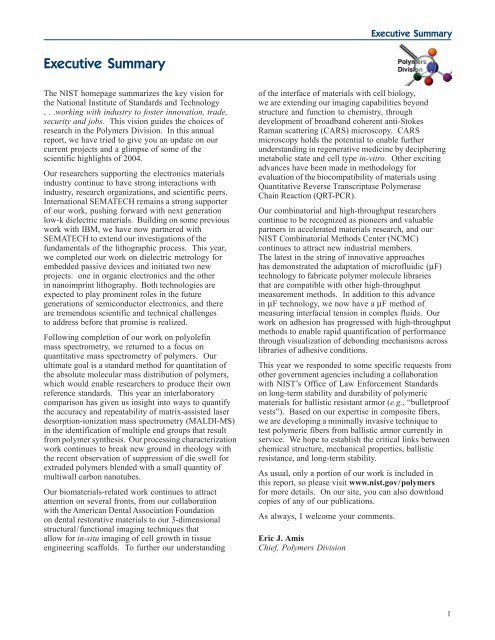Materials Science and Engineering Laboratory FY 2004 ... - NIST
Materials Science and Engineering Laboratory FY 2004 ... - NIST
Materials Science and Engineering Laboratory FY 2004 ... - NIST
You also want an ePaper? Increase the reach of your titles
YUMPU automatically turns print PDFs into web optimized ePapers that Google loves.
Executive Summary<br />
The <strong>NIST</strong> homepage summarizes the key vision for<br />
the National Institute of St<strong>and</strong>ards <strong>and</strong> Technology<br />
. . .working with industry to foster innovation, trade,<br />
security <strong>and</strong> jobs. This vision guides the choices of<br />
research in the Polymers Division. In this annual<br />
report, we have tried to give you an update on our<br />
current projects <strong>and</strong> a glimpse of some of the<br />
scientific highlights of <strong>2004</strong>.<br />
Our researchers supporting the electronics materials<br />
industry continue to have strong interactions with<br />
industry, research organizations, <strong>and</strong> scientific peers.<br />
International SEMATECH remains a strong supporter<br />
of our work, pushing forward with next generation<br />
low-k dielectric materials. Building on some previous<br />
work with IBM, we have now partnered with<br />
SEMATECH to extend our investigations of the<br />
fundamentals of the lithographic process. This year,<br />
we completed our work on dielectric metrology for<br />
embedded passive devices <strong>and</strong> initiated two new<br />
projects: one in organic electronics <strong>and</strong> the other<br />
in nanoimprint lithography. Both technologies are<br />
expected to play prominent roles in the future<br />
generations of semiconductor electronics, <strong>and</strong> there<br />
are tremendous scientific <strong>and</strong> technical challenges<br />
to address before that promise is realized.<br />
Following completion of our work on polyolefin<br />
mass spectrometry, we returned to a focus on<br />
quantitative mass spectrometry of polymers. Our<br />
ultimate goal is a st<strong>and</strong>ard method for quantitation of<br />
the absolute molecular mass distribution of polymers,<br />
which would enable researchers to produce their own<br />
reference st<strong>and</strong>ards. This year an interlaboratory<br />
comparison has given us insight into ways to quantify<br />
the accuracy <strong>and</strong> repeatability of matrix-assisted laser<br />
desorption-ionization mass spectrometry (MALDI-MS)<br />
in the identification of multiple end groups that result<br />
from polymer synthesis. Our processing characterization<br />
work continues to break new ground in rheology with<br />
the recent observation of suppression of die swell for<br />
extruded polymers blended with a small quantity of<br />
multiwall carbon nanotubes.<br />
Our biomaterials-related work continues to attract<br />
attention on several fronts, from our collaboration<br />
with the American Dental Association Foundation<br />
on dental restorative materials to our 3-dimensional<br />
structural/functional imaging techniques that<br />
allow for in-situ imaging of cell growth in tissue<br />
engineering scaffolds. To further our underst<strong>and</strong>ing<br />
Executive Summary<br />
of the interface of materials with cell biology,<br />
we are extending our imaging capabilities beyond<br />
structure <strong>and</strong> function to chemistry, through<br />
development of broadb<strong>and</strong> coherent anti-Stokes<br />
Raman scattering (CARS) microscopy. CARS<br />
microscopy holds the potential to enable further<br />
underst<strong>and</strong>ing in regenerative medicine by deciphering<br />
metabolic state <strong>and</strong> cell type in-vitro. Other exciting<br />
advances have been made in methodology for<br />
evaluation of the biocompatibility of materials using<br />
Quantitative Reverse Transcriptase Polymerase<br />
Chain Reaction (QRT-PCR).<br />
Our combinatorial <strong>and</strong> high-throughput researchers<br />
continue to be recognized as pioneers <strong>and</strong> valuable<br />
partners in accelerated materials research, <strong>and</strong> our<br />
<strong>NIST</strong> Combinatorial Methods Center (NCMC)<br />
continues to attract new industrial members.<br />
The latest in the string of innovative approaches<br />
has demonstrated the adaptation of microfluidic (µF)<br />
technology to fabricate polymer molecule libraries<br />
that are compatible with other high-throughput<br />
measurement methods. In addition to this advance<br />
in µF technology, we now have a µF method of<br />
measuring interfacial tension in complex fluids. Our<br />
work on adhesion has progressed with high-throughput<br />
methods to enable rapid quantification of performance<br />
through visualization of debonding mechanisms across<br />
libraries of adhesive conditions.<br />
This year we responded to some specific requests from<br />
other government agencies including a collaboration<br />
with <strong>NIST</strong>’s Office of Law Enforcement St<strong>and</strong>ards<br />
on long-term stability <strong>and</strong> durability of polymeric<br />
materials for ballistic resistant armor (e.g., “bulletproof<br />
vests”). Based on our expertise in composite fibers,<br />
we are developing a minimally invasive technique to<br />
test polymeric fibers from ballistic armor currently in<br />
service. We hope to establish the critical links between<br />
chemical structure, mechanical properties, ballistic<br />
resistance, <strong>and</strong> long-term stability.<br />
As usual, only a portion of our work is included in<br />
this report, so please visit www.nist.gov/polymers<br />
for more details. On our site, you can also download<br />
copies of any of our publications.<br />
As always, I welcome your comments.<br />
Eric J. Amis<br />
Chief, Polymers Division<br />
1

















